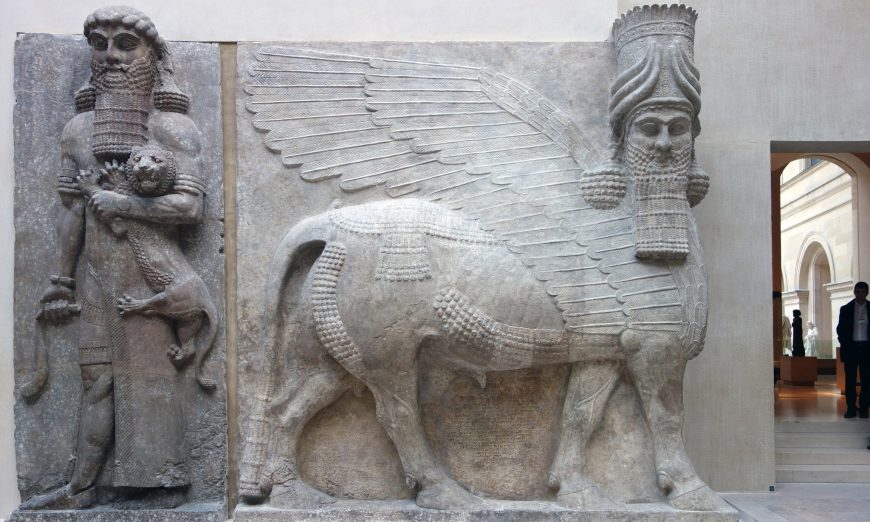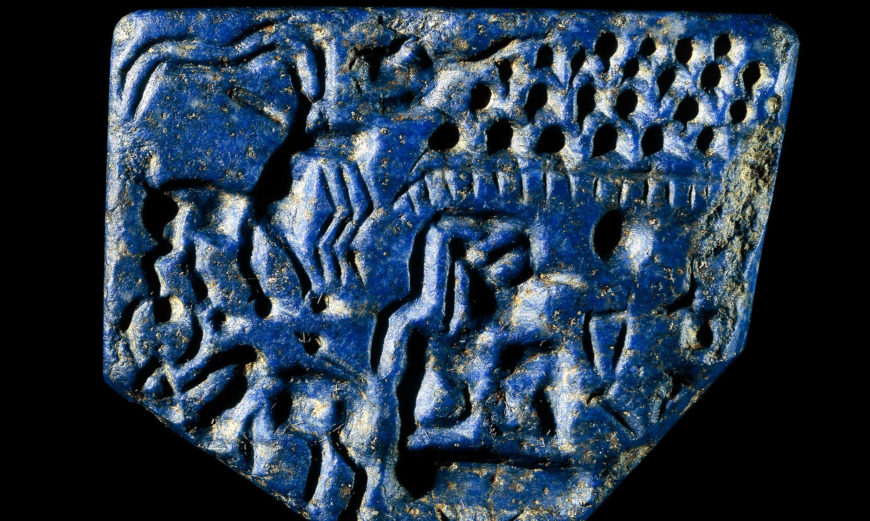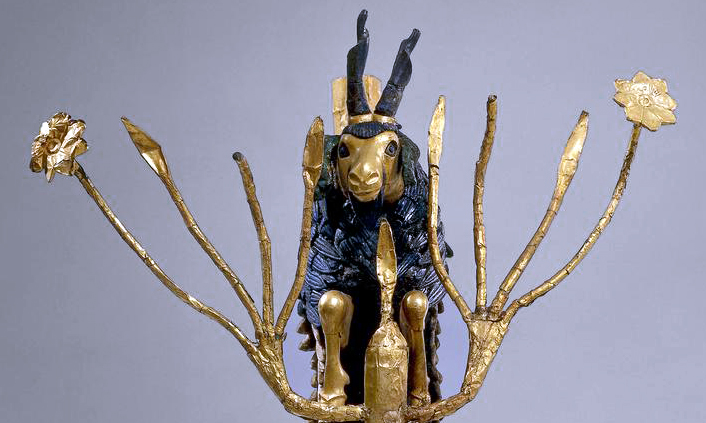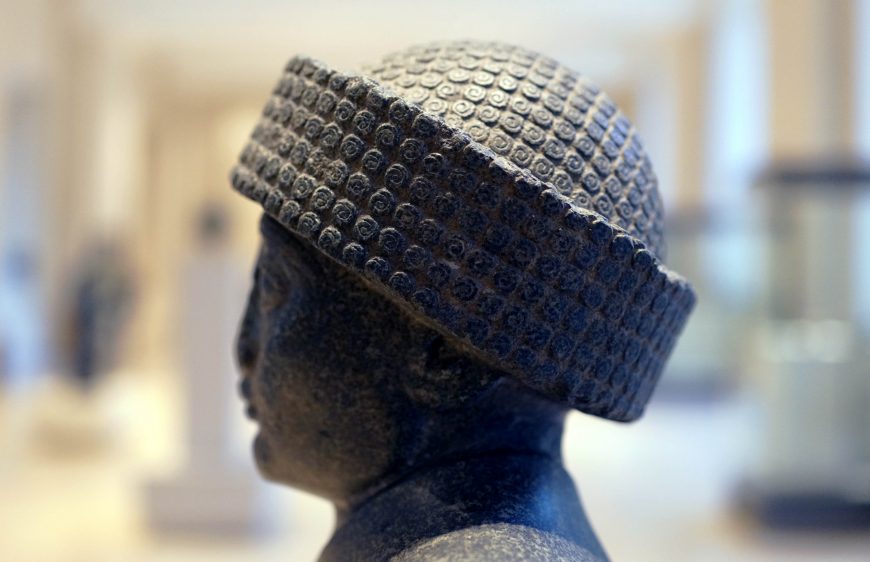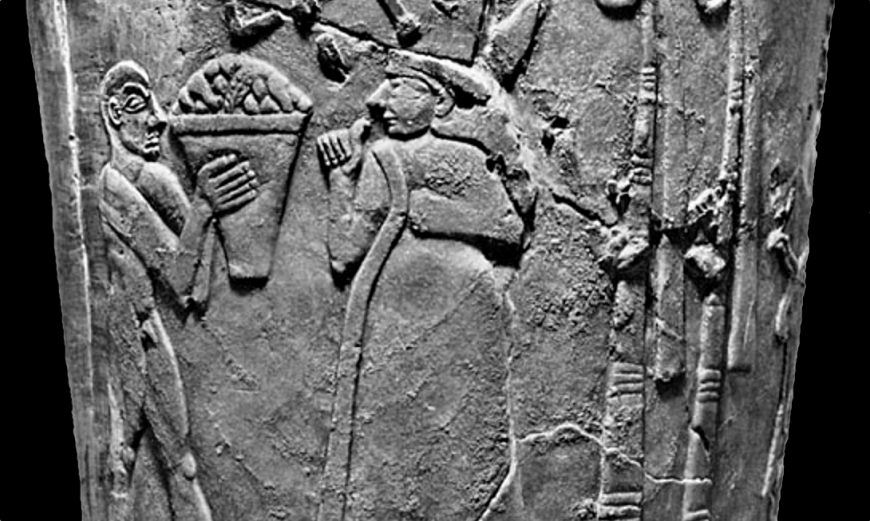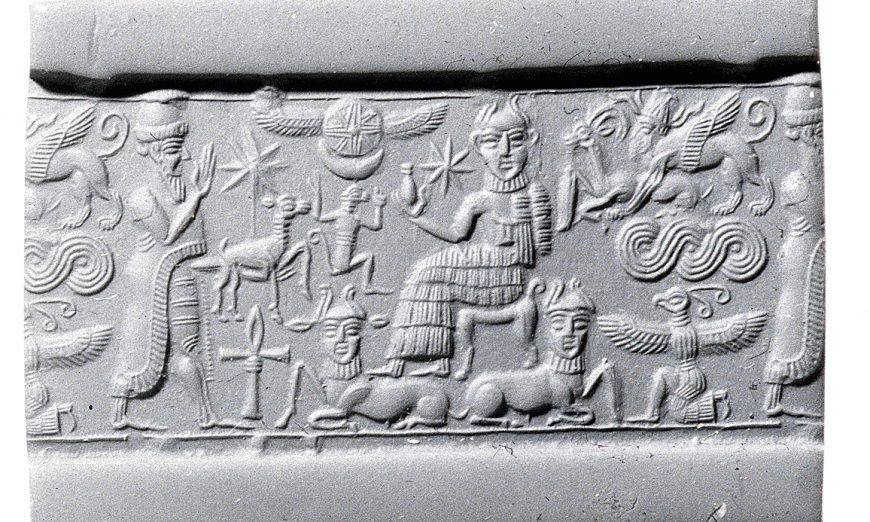From every angle, the Black Obelisk conveys that Shalmaneser III was widely powerful and well connected in the ancient world.
The Black Obelisk, 825 B.C.E. (Neo-Assyrian), black limestone, 197.48 x 45.08 x 60.96 cm (The British Museum, London). Speakers: Dr. Senta German and Dr. Beth Harris
[music]
0:00:06.3 Dr. Beth Harris: We’re in the galleries dedicated to the art of ancient Assyria here in the British Museum. And when we think about ancient Assyria, we think about an enormous empire.
0:00:16.2 Dr. Senta German: With huge palaces and huge temples and huge monuments to war and conquest.
0:00:21.5 Dr. Beth Harris: And we’re looking at a particular monument that was found in the ancient Assyrian City of Nimrud.
0:00:27.2 Dr. Senta German: Excavated by Austin Henry Layard, it’s called the Black Obelisk. And this was erected by a great Assyrian king, Shalmaneser III, in the 9th century B.C.
0:00:38.5 Dr. Beth Harris: So we’re looking at an object that is nearly 3,000 years old, and it survived remarkably well. When we walk up close, we can clearly make out all the scenes that are represented here.
0:00:50.8 Dr. Senta German: And there’s a lot of scenes, but typical for ancient Near Eastern art, there’s divided in a very orderly fashion in layers, like in a layer cake.
0:01:00.5 Dr. Beth Harris: So we actually have a very strict order to what we’re seeing here.
0:01:03.8 Dr. Senta German: And that order is such that what’s at the top is the most important. And at the top, at the front of this obelisk, we see King Shalmaneser III. He is the tallest guy. He’s wearing the typical fez hat of an Assyrian king.
0:01:19.2 Dr. Beth Harris: And he’s bearded.
0:01:20.5 Dr. Senta German: Which, of course, was a great sign of power and distinction in the ancient Near Eastern world. And he’s holding in one hand arrows, and in his other hand, he’s holding the top of his massive bow.
0:01:31.0 Dr. Beth Harris: And what’s so interesting to me about this top register is the emptiness in the center, which draws our eye toward a figure who is bending down toward the king.
0:01:41.1 Dr. Senta German: And this gesture of supplication on your knees, showing respect and probably a little bit of fear, not looking at the person whom you’re supplicating was typical in the ancient world.
0:01:51.8 Dr. Beth Harris: Above that are two symbols.
0:01:54.0 Dr. Senta German: And any kind of symbol that floats up in the sky, especially around a Assyrian king, is a symbol of a god. And the association of the symbol with that king means that the king is showing respect to the gods and the gods are giving him power. There are two symbols there. One on the left looks like a star in a circle. And that is the symbol of the goddess Ištar, the goddess of war, and a great, very important goddess in the ancient Near Eastern pantheon. And next to that is a winged disc. And that is the symbol of the god Aššur, king of the pantheon of gods.
0:02:27.2 Dr. Beth Harris: And then we see two attendants.
0:02:29.4 Dr. Senta German: The first attendant has a long beard, and he also has a weapon. The gentleman behind him is beardless and is probably one of the eunuchs in the court of the Assyrian king. The supplication here is specifically King Sua, who comes from a region of western Iran which was a very important one for trade in the Assyrian empire and also a source of a very important military tool, the horse.
0:02:55.8 Dr. Beth Harris: We’re looking at relationships between the Assyrian king and different regions of the ancient world.
0:03:04.6 Dr. Senta German: This is one of the jobs this obelisk has to do. When we imagine someone coming to the palace of Nimrud, they would see five regions showing either submissive relationship to Shalmaneser III or a very important relationship of exchange.
0:03:20.4 Dr. Beth Harris: So at the top we have an area in western Iran.
0:03:22.9 Dr. Senta German: And then beneath that is a region which in this period of time was referred to as Samaria, modern day Israel. That is the king of Samaria, Jehu. He is supplicating and we see him looking down at the ground, and Shalmaneser III is standing in front of him. And this time, interestingly, the symbols of Aššur and Ištar are reversed, which makes us wonder why. Possibly Shalmaneser III is acting more in a head of state manner than in a manner of warfare. But again, we see the same composition. We have a couple of attendants. The second attendant holds what looks like a modern day umbrella, a parasol, which is very common in Assyria. And they would not only mark the space of the king, but of course, give him shade and cover, and then a couple of more attendants.
0:04:09.0 Dr. Beth Harris: So let’s talk about the regions that are shown in the bottom three registers. Here we immediately notice two camels.
0:04:17.4 Dr. Senta German: Just like today in antiquity, camels were associated with the arid regions of northern Africa. This is a panel which describes the trade relationship between Assyria and Egypt.
0:04:27.3 Dr. Beth Harris: Below that, what looks like a lion hunt.
0:04:28.0 Dr. Senta German: This representation of a lion hunt, and specifically a lion grabbing the hindquarters of some sort of gazelle-like animal, this is a classic motif from some of the earliest periods of the ancient Near East. This panel represents an area of southern Mesopotamia.
0:04:45.6 Dr. Beth Harris: In the final register, we see figures.
0:04:49.1 Dr. Senta German: Five men who are carrying different kinds of tribute to Shalmaneser III. We see them carrying bundles of wood, two big horns of ivory. And we see a big cauldron, and that’s probably made of bronze, and it was probably valued just for the material from which it was made. This, the bottom panel, is tribute from the region of Hatay, which is southern Turkey today. They all wear the same soft cap which is associated with this region of the Near East. There’s an incredible kind of visual clarity to this. It is a monument to be read. There’s nothing chaotic or confusing about any bit of it. And that sense of order is reflected even more deeply in the representation of particular passages of, for instance, fur or hair or even leaves on trees. We see, for instance, the fringes of the richly tufted clothing of the Assyrian king and court. Each of those tufted passages are represented with regular lines to indicate the fullness of the fur or the way in which the fronds of the palm trees are represented, which, of course, is not true in nature. Each one is shown individually, and that’s just a classic aspect of ancient Near Eastern style.
0:06:01.4 Dr. Beth Harris: And we could see that even in the anatomy of the human figures in their forearms, where the musculature is clearly delineated.
0:06:10.1 Dr. Senta German: It’s so important to show that big, juicy calf muscle.
0:06:14.2 Dr. Beth Harris: In art history, we tend to study cultures very separately, but here I’m reminded that these are cultures that interrelated with one another.
0:06:24.0 Dr. Senta German: We don’t have a lot of monuments that show that visually, and this is one of them.
0:06:28.8 Dr. Beth Harris: At the very bottom is a tall area filled only with writing, with cuneiform.
0:06:34.0 Dr. Senta German: And that, of course, would have been the purview of people who were literate, people maybe, who didn’t know how to read, would focus on the images. The inscription is a version of what’s called the standard inscription, which talks about all of the military victories of the king. And this would redouble what is represented in images on the obelisk. It’s reminding the reader that Shalmaneser III is a conqueror of this vast region, a trade partner with this vast region of northern Africa, Egypt, so much of the ancient Near Eastern world. This obelisk was discovered at the entrance of the palace of Shalmaneser III at Nimrud. This was seen when you entered the palace and when you exited it. From every angle, you got the same message that Shalmaneser III was widely powerful and feared and well connected in the ancient world.
[music]


